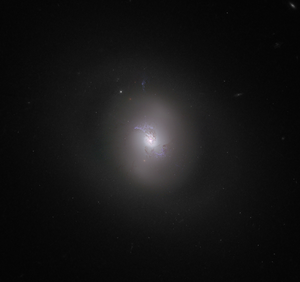NGC 3516
| Galaxy NGC 3516 |
|
|---|---|

|
|
| Photo from the Hubble Space Telescope | |
| AladinLite | |
| Constellation | Big Bear |
|
Position equinox : J2000.0 , epoch : J2000.0 |
|
| Right ascension | 11 h 06 m 47.5 s |
| declination | + 72 ° 34 ′ 07 ″ |
| Appearance | |
| Morphological type | (R) SB (s) 0 ^ 0 ^: / Sy1.5 |
| Brightness (visual) | 11.5 likes |
| Brightness (B-band) | 12.5 mag |
| Angular expansion | 1.9 ′ × 1.4 ′ |
| Position angle | 30 ° |
| Surface brightness | 12.4 mag / arcmin² |
| Physical data | |
| Affiliation | LGG 224 |
| Redshift | 0.008836 +/- 0.000023 |
| Radial velocity | 2649 +/- 7 km / s |
|
Stroke distance v rad / H 0 |
(124 ± 9) · 10 6 ly (38.0 ± 2.7) Mpc |
| history | |
| discovery | William Herschel |
| Discovery date | April 3, 1785 |
| Catalog names | |
| NGC 3516 • UGC 6153 • PGC 33623 • CGCG 334-011 • MCG + 12-11-009 • IRAS 11033 + 7250 • 2MASX J11064749 + 7234066 • GC 2298 • H II 336 • h 816 • LDCE 760 NED003 | |
NGC 3516 is a lenticular galaxy with an active nucleus of the Hubble type SB0 in the constellation Great Bear. It is an estimated 124 million light years away from the Milky Way and has a diameter of about 65,000 ly.
The galaxy exhibits an extraordinary fluctuation in brightness over time in the X-ray range .
The object was discovered on April 3, 1785 by the astronomer William Herschel with an 18.7-inch telescope and is recorded in the New General Catalog .
Web links
Commons : NGC 3516 - collection of images, videos, and audio files
